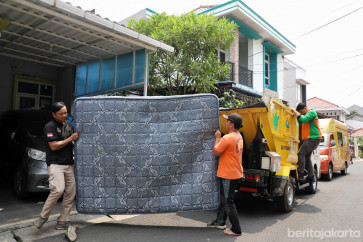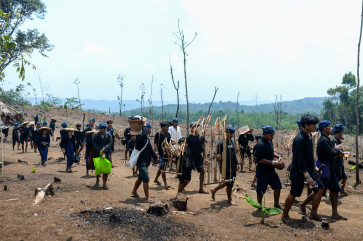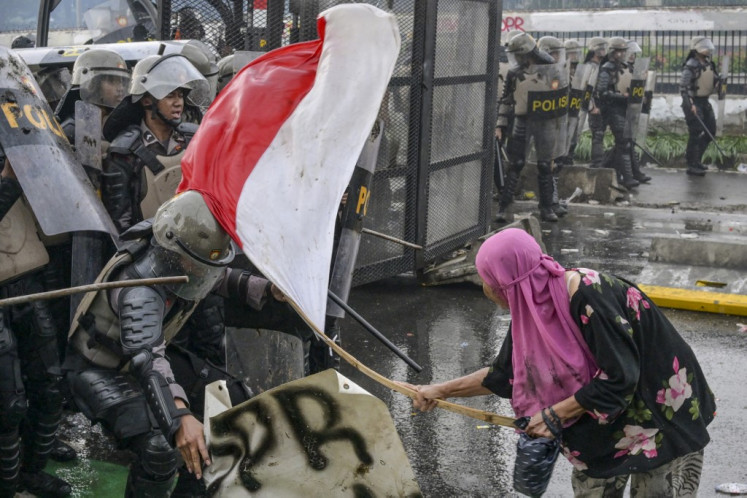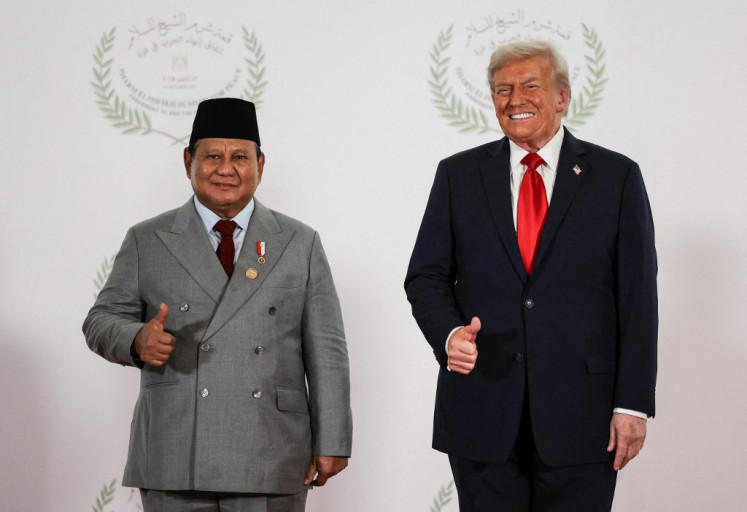Popular Reads
Top Results
Can't find what you're looking for?
View all search resultsPopular Reads
Top Results
Can't find what you're looking for?
View all search resultsPuppet shows cheer up festival
Ony and his little piglet greet audience
Change text size
Gift Premium Articles
to Anyone
Ony and his little piglet greet audience. JP/Ani Suswantoro
Some museums recently organized an event to introduce the rich traditions of old Jakarta, also known as Batavia, to the public.
The Puppetry Museum, the Jakarta Museum of History and the Arts and Ceramics Museum teamed up to present the “Visit Museum Year”. The Gebyar Taman Fatahillah, which was held from Nov. 20-Dec. 12, was a sideline event.
The event opened with the Festival Tempo Doeloe, which presented the old days of Jakarta, on Nov. 20. On the schedule was a tour of Jakarta’s old city, the Batavia Art Festival, a puppetry festival, ceramics and Betawi painting exhibitions at the Arts and Ceramic Museum and a wayang kulit traditional leather puppet workshop.
The puppetry festival presented puppets from various parts of Indonesia such as the Po The Hi, Wayang Golek Sunda, Wayang Kulit Betawi, Wayang Purwo Solo, as well as Malaysian and Filipino puppets.
The secretary-general of the ASEAN Puppet Association, Tupuk Sutrisno, said at the festival that wayang almost always meant leather puppets in Indonesia.
In an international context, “puppet” might also mean “puppetry” or “marionettes”, he said. All ASEAN countries have traditional puppets, except Brunei, which consider puppets a Hindu tradition.
The existence of a dalang (puppeteer), a gamelan orchestra, waranggana (singers) and the sophisticated carving of the puppets all went into UNESCO’s consideration to include Indonesian puppets in the Representative List of the Intangible Cultural Heritage of Humanity.
Indonesian wayang’s high value lay in its philosophy and moral teachings which encompass almost all aspects of life — including ways to manage a nation and run a government.
Indeed, we can learn a lot from wayang performances.
Puppet troupes from the Philippines and Malaysia performed at Wayang Museum on that day.
Ventriloquist Ony Carmano, 44; puppeteer Danilo Liwanag, 57, and table puppeteer Casius Ramirez represented the Philippines.
The trio are members of pioneer Philippine puppetry group Samahan ng mga Papetir ng Philippinas (SPP), which was established in 2007. SPP aims to develop, promote and preserve the art of puppetry.
Ony, utilizing wacky and colorful dolls, such as a pink piglet and a young boy named Nonoy, included character-building messages in his performance. He said that his unique show, which used ventriloquism, was an effective tool to convey his ideas.
The bright-colored Malaysian puppets after a show. JP/Ani Suswantoro
The show at Wayang Museum was opened by Ony, who explained ventriloquism and taught the audience how to do it. He told the audience that they only needed to store their voice in a plastic water bottle and cover it with their palms. When the bottle was opened, the voice would come out, he said.
He practiced what he said. There it was: his voice popped out of the bottle, even when his lips were tightly closed! His lesson drew laughter and amazement from the audience.
After that, a pink piglet appeared speaking in a childish, coquettish voice to greet the children.
Next Danny and Casius performed with their white swan, which danced vivaciously, leaping from the table and up into the air. Orchestral music played and the swan transformed into an elegant ballerina.
Danny’s and Casius’ black attire was able to highlight the white swan.
Nonoy, after shaking hands with the front row spectators, told children to study hard if they were to succeed in their lives.
The last part of the show was the marshmallow man by Danny and Casius, who performed a pantomime set to Michael Jackson tunes. Danny was excited, saying that the Jakarta audience was very enthusiastic.
“Used creatively, puppetry, which is a very effective tool, could promote culture, education as well as entertainment. I also believe that cooperation in puppetry will also improve ties among ASEAN countries,” he said.
A Malaysian puppet trio presented a story titled Wong Anum Kertapati, which depicted Rahwana, the evil king of Alengka, who transformed himself into a young man to seduce Sita, Rama’s wife.
The leader of the group was Yusuf Mamat, 59, who acted as puppeteer and singer simultaneously, assisted by Suhaimi, 39, as co-puppeteer.
Their leather puppets were made of buffalo hide and painted in bright colors. Their group, Kencana Putra, performs in Kelantan.
“We play Ramayana epics, usually for three hours, at parties, gatherings or official events. But it’s a pity that nowadays the younger generation doesn’t like puppet very much,” Suhaimi said.
“The difference from Indonesian puppets is the names of the characters. For example we say ‘Site Dewi’ for ‘Dewi Sinta’ and ‘Pohon Beringin’ for ‘Gunungan’. Others are relatively similar,” Yusuf said.
Nonetheless I noticed a striking difference: the Javanese wayang had sophisticated karawitan as background music, while Yusuf’s puppets were accompanied by Melayu musical instruments.
The more we attend our wayang performance, the better our appreciation — and the deeper our love and commitment will be to preserve it.











